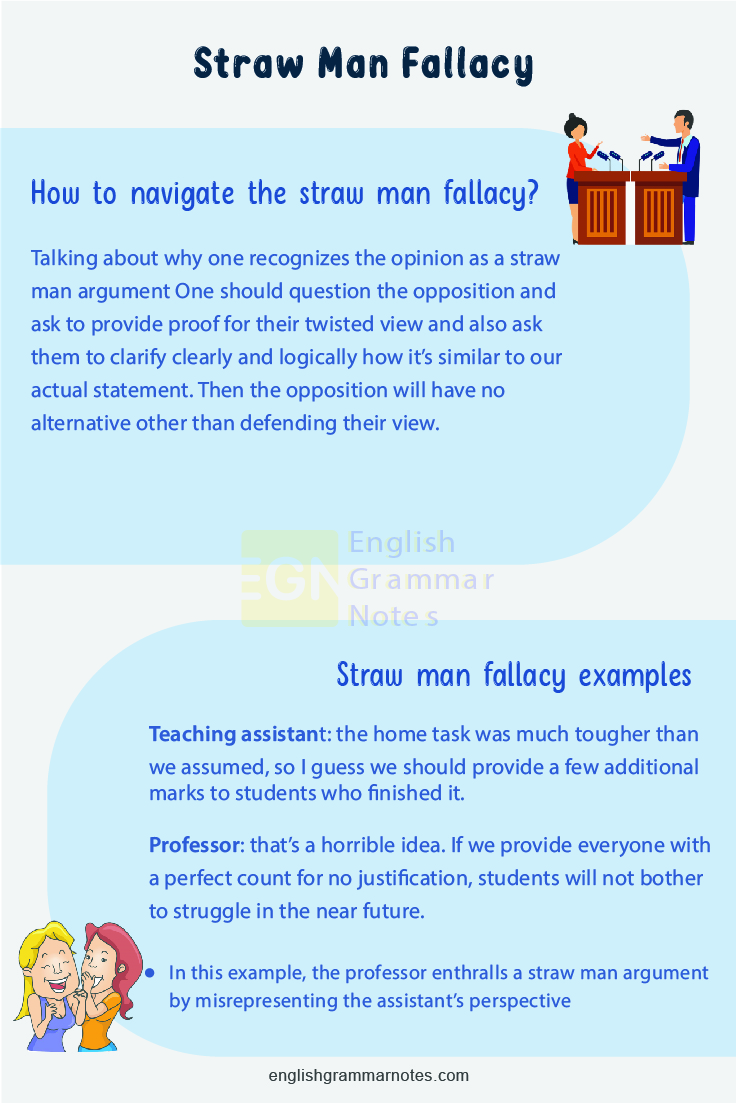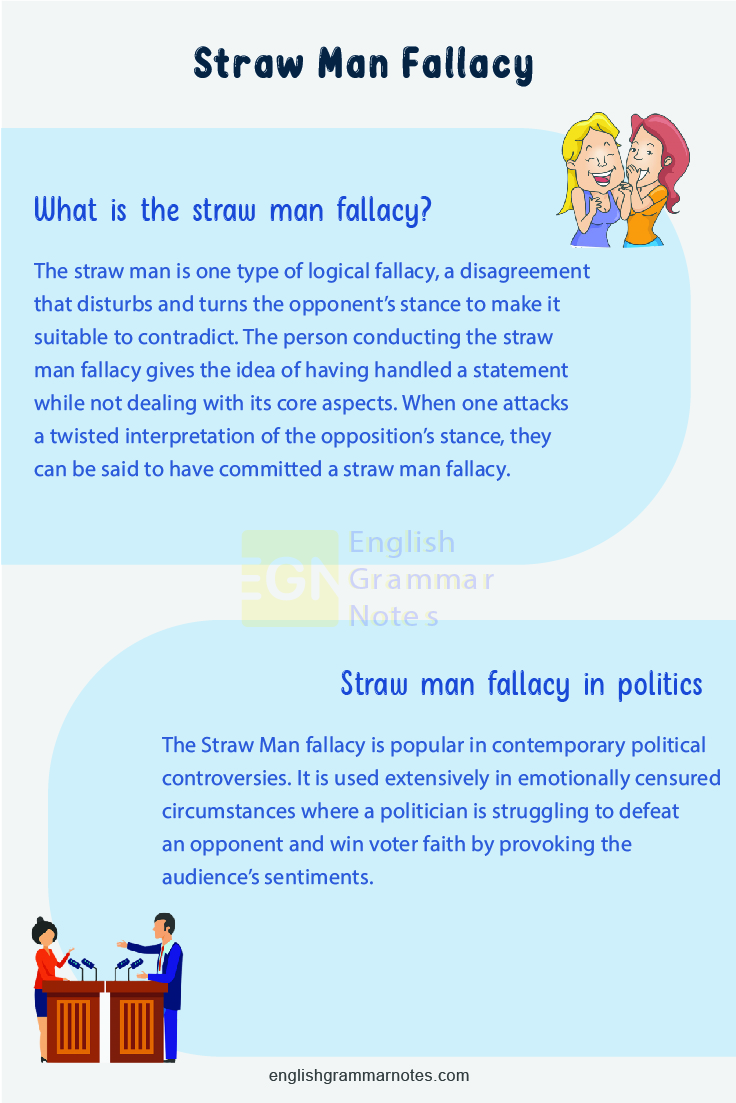Straw Man Fallacy Examples: A straw man fallacy appears when an individual takes another individual’s argument and distorts it in some drastic way and then attacks the severe distortion as if that is the statement the first individual is creating.
In this article, we shall talk in detail about straw man fallacy which includes topics like what is a straw man fallacy, straw man fallacy in politics, what is meant by straw man argument, straw man philosophy, straw man fallacy examples, straw man vs red herring examples, etc. To know further about this, refer to this article.
Straw Man Fallacy Examples in English
- What is the straw man fallacy?
- Straw man fallacy examples
- What is the straw man argument?
- Different kinds of straw man arguments
- How to navigate the straw man fallacy?
- Straw man vs red herring
- Straw man fallacy in politics
- Key points to know when you’re countering a straw man argument
- Wrap up
What is the straw man fallacy?
The straw man is one type of logical fallacy, a disagreement that disturbs and turns the opponent’s stance to make it suitable to contradict. The person conducting the straw man fallacy gives the idea of having handled a statement while not dealing with its core aspects. When one attacks a twisted interpretation of the opposition’s stance, they can be said to have committed a straw man fallacy.
The term appears from the impression of an artificial man of straw or scarecrow who is detected as a weak opponent.
Straw man fallacy examples
The straw man fallacy depends on verbal manipulation of the opposite perspective; it has varied ideas. Only when one knows to identify the straw man fallacy can one move towards the action of rebutting. They point only to some specific factors of the opponent’s argument and refer to a part of the opponent’s argument out of context.
These cases will give one an impression of what a straw man fallacy includes and how to go past it.
Here is a common example of a straw-man argument:
Teaching assistant: the home task was much tougher than we assumed, so I guess we should provide a few additional marks to students who finished it.
Professor: that’s a horrible idea. If we provide everyone with a perfect count for no justification, students will not bother to struggle in the near future.
In this example, the professor enthralls a straw man argument by misrepresenting the assistant’s perspective in these ways:
- The professor argues against providing each one additional marks, while the teaching assistant proposed to give it only to students who completed the homework.
- The professor contends against giving students an extra score, while their assistant suggested providing students with just a few additional points. The professor argues against giving students a different point for no purpose, while their assistant gave them the bonus because the assignment was tougher than expected.
- In doing all of this, the professor creates it much simpler for themself to attack the assistant’s stance.
It does not count whether the professor’s general assertions who uses the straw-man are valid or not. This is because the professor’s argument is an inaccurate misconstruction of their opponent’s perspective.

What is the straw man argument?
Mostly, the usage of the straw man fallacy includes these steps:
- Somebody begins by expressing their position. This can comprise opening declarations, observations, statements, or evidence. They present their issue, present recommended changes, and provide adequate proof to assist their stance.
- Then the second person presents a distorted statement of the first person’s actual description. They do this while acting like there is no substantial variation between the two editions. The second person is executing a distinct proposition and passing it off as the first person’s idea.
Then, they drive all out to abolish the straw man they have set up so that the public is thrashed off and begins to think that the second person has thoroughly thwarted the first person’s argument.
Caught off, the second person starts to attack the first person’s twisted statement of their actual argument. This makes the issue more confused for the audience. The second person has been successful in initiating chaos and changing the purposes of the debate.
Different kinds of straw man arguments
There different variations of the straw man fallacy are listed below:
Hollow Man arguments
It is more severe than straw man arguments. Here, individuals falsely develop the viewpoints, and they declare it was formulated by people they oppose. They argue with oppositions who don’t exist, therefore setting them in an advantageous position. It’s a vague way of making a big disagreement without the pressure of responsibility.
Iron-man arguments
It is created in the same ways as a straw-man argument, that is, by misleading the actual stance. Nevertheless, in this issue, people build their position so that it is simpler to defend. These statements are hard to avoid because they have many overlapping characteristics with good controversial strategies.
People use vague and confusing terms so that no one can question those statements.
Steel-man argument
It is an argument that alters an opposing statement to rectify it, commonly to make it harder to attack. Building a steel man argument involves illustrating the wording of a statement to exclude pre-existing subjects with it.
How to navigate the straw man fallacy?
So now, when straw man meaning is discussed clearly, let us see how we can manage this situation. The choices include:
Talking about why one recognizes the opinion as a straw man argument
One should question the opposition and ask to provide proof for their twisted view and also ask them to clarify clearly and logically how it’s similar to our actual statement. Then the opposition will have no alternative other than defending their view.
Avoiding the straw man argument totally
One should continue to elaborate one’s original point that will move the discussion back to the fact one is trying to make.
Deciding to confront with the Straw man argument
Even when the opinion is forced, one can state why it’s unassociated and unrelated to the actual perspective. One can refer to statistics revealing how the two declarations appear identical but are distinct.
Straw man vs red herring
Straw man fallacy is another type of fallacy and is mostly found in political debates. But you must know about the structure of these arguments to understand the examples of the straw man fallacies. The system of these arguments consists of two persons: person A and person B.
Person A claims something, and then person B makes a distorted version of that claim which we call straw man and then attacks it to refute person A. So, it’s often that the distorted claim is barely related to the original claim. It’s more like distracting the argument from the real issue and turning it into an illogical argument.
The twisted statement is only distantly related to the original claim. The opposition statement may point to just one element of the claim, exaggerating it and bringing it out of context. The straw man argument, in this manner, is an instance of a red herring. It’s meant to divert from the actual issue being talked about and is not a logically reasonable contention.
In brief, a red herring is a fallacy that diverts from the case at hand by giving rise to an insignificant disagreement. In contrast, a straw man is a red herring as it detracts from the main topic by incorrectly coating the opposition’s argument.
Straw man fallacy in politics
The Straw Man fallacy is popular in contemporary political controversies. It is used extensively in emotionally censured circumstances where a politician is struggling to defeat an opponent and win voter faith by provoking the audience’s sentiments.
Politics is a prominent area to find practical fallacies, especially straw man arguments.
If we consider the debatable issue of common healthcare, also known as Medicare for all.
Politician A: Providing Medicare for all residents would be high-priced and a danger to the free market.
Politician B: You don’t mind if people expire for not having healthcare.
Politician A’s stance is about the outcome of common healthcare on the free market, as it would jeopardize the private security enterprise. Politician B has avoided that argument and made it about not looking after if people expire. Now Politician A has to uphold their sense of kindness rather than their fiscal duty.

Key points to know when you’re countering a straw man argument
A good way to minimize one’s exposure to straw-man opinions in the first place is to use open and explicit wording so that little reconstruction is possible. This makes it more problematic for the adversary to alter one’s perception and makes it simpler for one to improve them if they strive to do so.
There are three main strategies commonly which one can use:
Question the straw-man
One can point out the straw-man and explain why the argument is misleading and state how it distorts the actual viewpoint. One can also ask them to justify their distorted opinion and why they think it’s the same as the original. As both are different, the opposition will either admit that their argument was invalid or try to explain using more deceptive reasoning, which one can counter then.
Avoid the straw-man
One can ignore the deformed interpretation of the statement that your opposition proposes and continue to sup rt the actual stance.
Recognize the straw-man
In several issues, it might be essential for one to accept a straw-man when one is endorsing their stance, which implies that instead of contending in favour of your actual stance, one could start asserting the contorted version of the view, as presented by your opponent.
Since a straw-man argument is misleading because it misrepresents its stance against it, the proper way to contradict it is to point out this contortion from a simply reasonable perspective. This is also the most beneficial option for countering the straw-man in some cases. Still, there are some circumstances where it is better to use an alternative method by either avoiding the straw-man or approving it.
Wrap up
This article states much information about strong man fallacies as it is important to recognize the logical fallacies, and strong man fallacies are one of them. Being worthy to identify and understand logical fallacies will provide one to interpret better and examine the importance of what somebody has to tell.